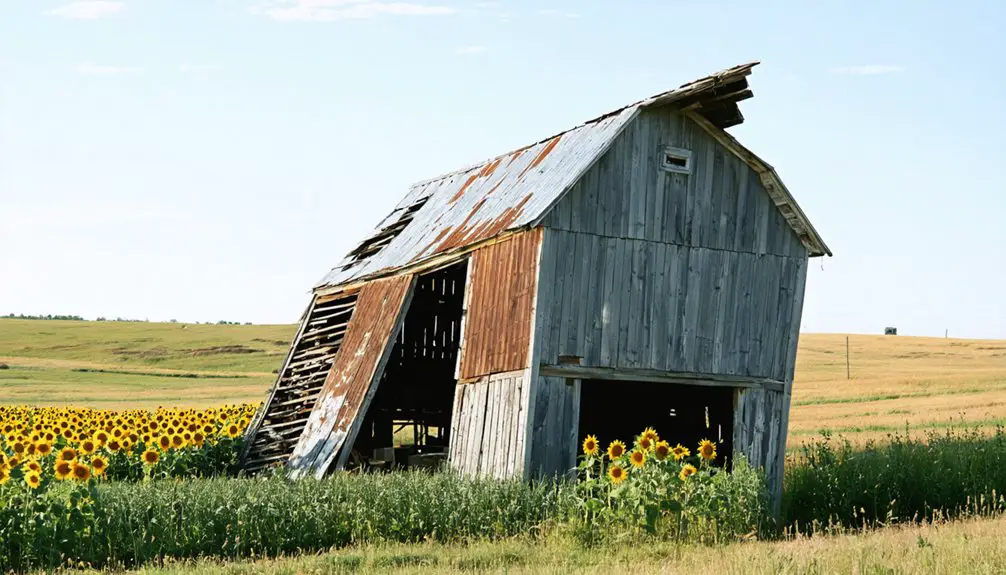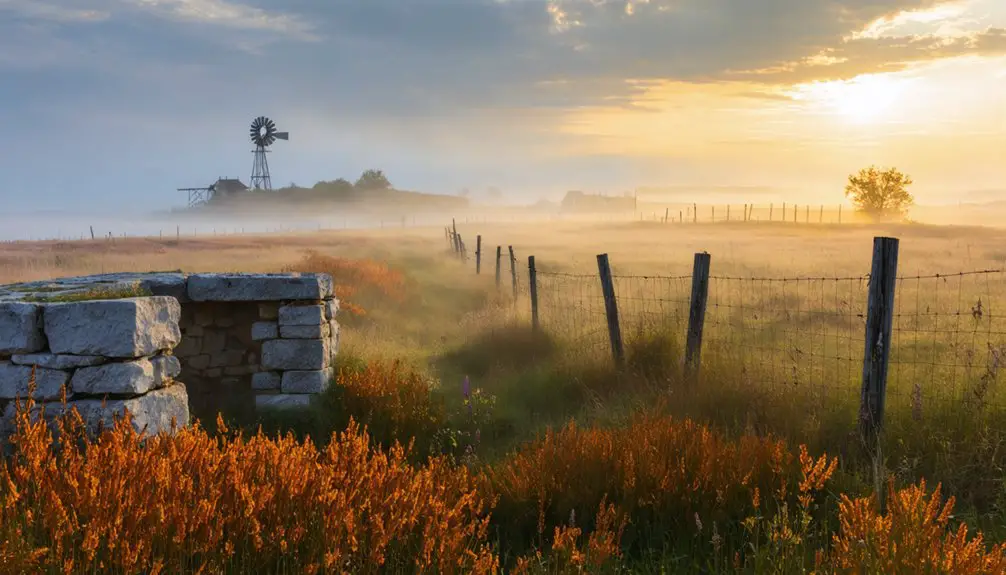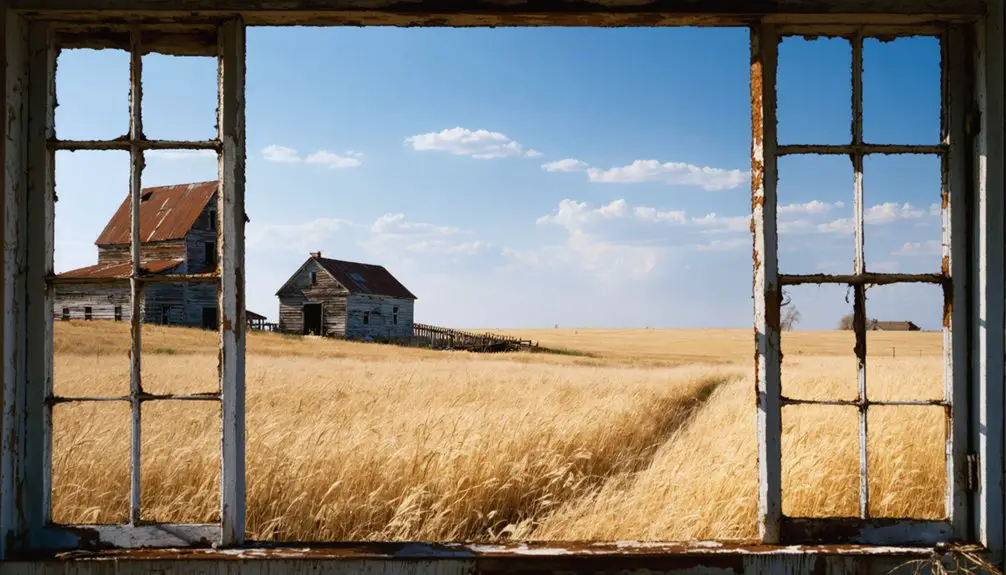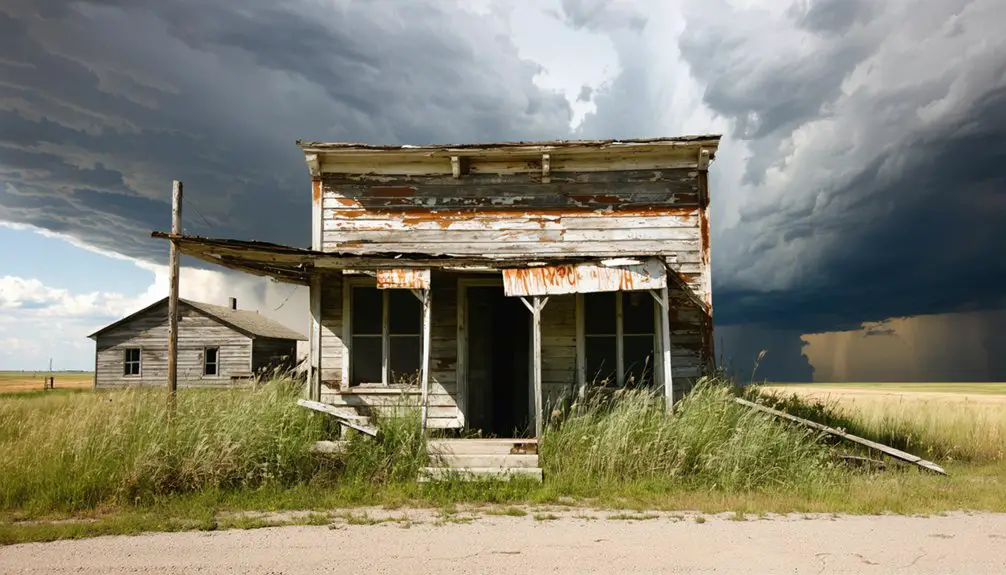You’ll find Comiskey, Kansas, tucked away in Morris County’s Flint Hills, where limestone buildings and weathered structures tell the story of a once-thriving railroad town. Named after baseball legend Charles Comiskey in the early 1900s, this ghost town served as a crucial Missouri Pacific Railway stop until post-WWII changes led to its decline. The abandoned buildings, silent grain elevators, and rocky terrain hold fascinating tales of baseball, railroads, and prairie life.
Key Takeaways
- Comiskey, Kansas was named after baseball player Charles Comiskey and established as a Missouri Pacific Railroad station town.
- The town’s decline began with highway development reducing railroad traffic and post-World War II agricultural mechanization reducing local employment.
- The closure of the Missouri Pacific Railway service and local cement factory contributed significantly to Comiskey becoming a ghost town.
- Architectural remains include limestone structures from the early 1900s, reflecting the town’s ranching heritage in Kansas’ Flint Hills region.
- Local historical societies maintain ghost town preservation efforts, including structural stabilization and documentation of remaining buildings.
The Baseball Connection Behind the Name
While many ghost towns earned their names from local geographical features or founding settlers, Comiskey, Kansas received its unique moniker from a Missouri Pacific Railway official’s admiration for Charles Comiskey, the renowned baseball player and manager of the St. Louis Browns.
This baseball tribute in town naming wasn’t an isolated incident – nearby Bushong was similarly named after Comiskey’s teammate. After attending Holy Family parochial school, he discovered his passion for baseball playing at Chicago’s Garden City grounds.
The connection deepened through Comiskey’s earlier ties to Kansas, where he’d attended St. Mary’s College in the 1870s alongside his brother James, who played catcher for the college team. After managing the Browns, he led them to four consecutive championships while establishing himself as a pivotal figure in baseball.
While Emporia fans credited the town’s name to Comiskey’s brilliant play, some of these local stories have been embellished.
Though Comiskey never visited the Kansas town bearing his name, he knew of its existence.
Early Days and Railroad Heritage
You’ll find that railroad companies in Kansas frequently named stations after prominent individuals, which explains Comiskey’s connection to the Missouri Pacific line.
The Missouri Pacific Railroad’s expansion through Morris County transformed Comiskey into a crucial transportation link between Council Grove and eastern markets. The town’s eventual decline began when highway development reduced local railroad traffic.
As a newly established rail stop, Comiskey developed the essential infrastructure needed for loading agricultural products and supplying local farmers with equipment and materials. Similar to Kansas City Pittsburgh railroad’s impact on Asbury’s growth, the Missouri Pacific line played a vital role in Comiskey’s development.
Railroad Naming Practices
The naming conventions weren’t just random choices – they served practical purposes in coordinating services between different rail lines.
When railroads shared routes or connected services, they’d carefully select names that honored their partners and fit both companies’ traditions.
For example, Pennsylvania Railroad used “Eagle-” prefixes for cars interchanging with Missouri Pacific. By 1916, over 1,200 carriers operated throughout the expansive U.S. rail network, making standardized naming essential.
Telegraph technology helped shape how railroads communicated names and information efficiently between stations.
Missouri Pacific’s Local Impact
Making history as the first steam railroad west of the Mississippi River, Missouri Pacific’s initial five-mile run from St. Louis to Cheltenham in 1852 marked the beginning of a transportation revolution.
You’ll find that within just three years, the line had reached Jefferson City, transforming the region’s connectivity and commerce.
The railroad’s presence brought an unprecedented economic boost to communities along its route.
When Jay Gould purchased the railroad in 1879, it marked a significant turning point in the company’s growth and development.
You’d have seen new job opportunities emerge in railroad employment, from construction crews to maintenance workers. The devastating cholera epidemic of 1849 initially delayed construction plans, but the railway’s eventual completion created numerous employment opportunities. Major repair facilities in Sedalia and North Little Rock created stable employment hubs.
The Missouri Pacific’s strategic route choices and integration with steamboat operations opened up new trade possibilities, while their infrastructure development spurred real estate growth.
Towns flourished around railroad centers, forever changing the landscape of local commerce and community development.
Transportation Hub Development
As Missouri Pacific’s influence spread westward, Kansas emerged as a significant crossroads of multiple transportation modes in the mid-1800s.
You’ll find that the transportation evolution began with river commerce, utilizing dugout canoes and flat-bottomed boats before expanding to include keelboats during the fur trade era. Commercial steamboats began operating in Kansas waters in 1829, marking a new era in river transportation.
The establishment of essential trade routes like the Santa Fe Trail transformed Kansas’s connectivity.
The Russell, Majors & Waddell company emerged as a dominant force in regional freight transportation, revolutionizing cargo movement across the territory.
You’d have seen prairie schooners carrying settlers and goods across the territory, while steamboats like the Excel navigated the Kansas River by 1854.
With the arrival of the Atchison, Topeka, and Santa Fe Railway by 1871, Kansas’s role as a transportation hub strengthened considerably.
The strategic placement of railroads near coal deposits guaranteed sustained growth, while ferry services across the Missouri River complemented the expanding transportation network.
Life in a Prairie Whistle Stop
Life in Comiskey during its heyday centered around the rhythmic pulse of passing trains on the Missouri Pacific Railroad.
You’d find community dynamics shaped by the Methodist church, schoolhouse, and civic pavilion, where neighbors gathered to strengthen their social bonds. Daily routines revolved around railroad schedules that dictated the flow of goods, mail, and visitors.
Agricultural practices dominated the working hours, with families supporting themselves through small-scale farming while relying on mutual aid from neighbors.
You’d experience a tight-knit social fabric where church events, school functions, and shared labor united the populace. The post office served as a crucial communication hub until the town’s decline in 1929, when changing transportation patterns and economic shifts led residents to seek opportunities elsewhere.
Architecture and Notable Structures

The architectural remains of Comiskey stand as silent witnesses to its former liveliness, with only scattered foundations and weathered remnants marking where a bustling prairie community once thrived.
You’ll find architectural styles typical of early 1900s rural Kansas, including the still-standing Zion Lutheran Church (1910-1996) and a modest schoolhouse that served as central gathering places.
The community layout reveals a well-planned settlement centered around the railroad, with buildings clustered nearby to support commerce.
You can spot traces of simple wood-frame homes with gabled roofs, reflecting the practical needs of working-class residents. Local timber dominated construction, while brick and stone were reserved mainly for foundations and chimneys.
Today, these deteriorating structures tell the story of a small but organized prairie town.
The Path to Abandonment
Following World War II, Comiskey’s decline accelerated due to multiple economic and social pressures that proved insurmountable for this small Kansas community.
The town’s fate was sealed by the perfect storm of agricultural mechanization, which drastically reduced the need for farm workers, and the loss of crucial Missouri Pacific Railway service that had been the town’s lifeline.
You’ll find that population decline snowballed as economic factors drove residents, especially younger generations, toward larger cities offering better opportunities.
The closure of the cement factory, a major regional employer, dealt another devastating blow.
As farms consolidated and modernized, fewer families remained to support local businesses and maintain community institutions.
Churches emptied, schools closed, and the remaining residents gradually drifted away, leading to the town’s eventual disestablishment.
Legacy in the Flint Hills

You’ll find Comiskey’s limestone structures still standing as silent witnesses to the town’s ranching heritage in the Flint Hills.
While the buildings have weathered decades of prairie winds, they reflect the region’s distinctive architectural style of using local stone that characterized early settlement patterns.
The ghost town’s rural character persists through continued cattle grazing on surrounding prairies, carrying forward both the name of baseball pioneer Charles Comiskey and the enduring agricultural legacy of this Kansas grassland.
Limestone Legacy Still Stands
While many Kansas ghost towns have vanished without a trace, Comiskey’s limestone legacy endures through the region’s distinctive architecture and geological features.
You’ll find this architectural heritage in the light gray and buff-colored Cottonwood Limestone that shaped the Flint Hills landscape, creating dramatic escarpments that define the region’s character.
The limestone significance extends beyond mere aesthetics. Local quarries, like those near Alma and Manhattan, supplied the sturdy stone that built the area’s most enduring structures.
When you explore the Flint Hills today, you’re witnessing a reflection of the industry that once thrived here. The limestone formations continue serving as crucial aquifers, supporting the region’s water resources while preserving the ecological balance that makes this area unique.
Rural Character Lives On
Despite the decline of many Kansas towns, Comiskey’s rural heritage persists through the Flint Hills’ enduring ranching traditions and pastoral landscapes.
You’ll find evidence of ghost town preservation in the remaining agricultural infrastructure – weathered barns, rusted fences, and silent grain elevators that echo the community’s farming roots.
The region’s rocky terrain, which prevented widespread plowing, helped maintain North America’s largest remaining tallgrass prairie. This natural barrier shaped Comiskey’s rural identity, favoring cattle operations over crop farming.
Today, you can witness this living heritage at nearby historic ranches like Crocker and Pioneer Bluffs, where traditional grazing practices continue.
While the railroad’s departure contributed to Comiskey’s population loss, the surrounding ranchlands preserve the authentic character of this Flint Hills community, carrying forward a legacy that spans generations.
Baseball Pioneer’s Prairie Town
As baseball pioneer Charles Comiskey rose to prominence in the late 19th century, the Missouri Pacific Railroad honored his legacy by naming a Kansas prairie town after him in 1886.
You’ll find Comiskey’s baseball heritage deeply woven into the Flint Hills region, where he first honed his skills at nearby St. Mary’s College. The town’s establishment reflected a unique practice of commemorating baseball figures during railroad expansion, strengthening the community identity of rural Kansas settlements.
While playing for and managing the St. Louis Brown Stockings, Comiskey’s influence reached beyond the diamond and into the prairie landscape.
Though the town no longer exists, its naming captured a moment when America’s pastime intersected with westward expansion, preserving the memory of baseball’s early innovators in Kansas‘s geographical history.
A Window Into Rural Kansas History

Through the lens of Comiskey’s abandoned structures and forgotten streets, you’ll discover a vivid portrait of late 19th-century rural Kansas life. The remaining schoolhouse, church, and civic pavilion stand as silent witnesses to the community dynamics that once thrived in this railroad whistle-stop.
You can trace the cultural shifts that transformed this vibrant town from its 1887 establishment to its decline in 1929. As you explore the site, you’ll find evidence of how railroad expansion shaped settlement patterns across the Midwest.
The town’s rise and fall mirrors broader changes in American life – from the railroad-dependent economy to the automobile age. Today, these weathered structures offer you a rare glimpse into an era when small prairie communities formed the backbone of Kansas society.
Preserving the Past Today
While modern Comiskey lies dormant, dedicated preservation efforts keep its historical legacy alive. You’ll find local historical societies leading ghost town preservation initiatives through site maintenance, structural stabilization, and careful documentation of remaining buildings and artifacts.
Community storytelling plays an essential role through oral histories, documentaries, and digital platforms that share Comiskey’s past with wider audiences. You can explore this heritage through educational programs, guided tours, and interactive exhibits that bring the town’s mining history to life.
Local volunteers actively participate in archaeological research and historical record-keeping, while public humanities grants support ongoing preservation projects. The rise of heritage tourism has encouraged responsible exploration of these historic sites, helping guarantee that Comiskey’s story endures for future generations through both physical conservation and digital storytelling.
Frequently Asked Questions
Can Visitors Access the Private Property to View Remaining Structures?
You can’t legally access this ghost town’s private property without the owner’s explicit permission, as trespassing laws protect the site. You’ll need to arrange authorized entry to view structures.
What Natural Disasters or Events Contributed to Comiskey’s Decline?
When tornadoes ripped through the region, you’d have seen devastating destruction of buildings and infrastructure. Unlike other Kansas towns, there’s no record of significant flood damage or drought effects impacting Comiskey’s decline.
Were There Any Famous Residents Besides Those Connected to Baseball?
You won’t find records of any famous residents or people of historical significance in this town beyond its baseball connection. Available documentation doesn’t mention any other notable inhabitants over time.
What Businesses Operated in Comiskey During Its Peak Years?
Walking through this ghost town’s dusty streets, you’d have found three general stores, two banks, a drugstore, doctor’s office, attorney, barber, gristmill, sawmill, dance halls, and gambling establishments of historical significance.
How Many People Lived in Comiskey at Its Highest Population?
You’ll find that the peak population reached 924 people around 1920, marking the town’s most significant population growth and historical significance during the height of its coal mining operations.
References
- https://www.wikiwand.com/en/map/Comiskey
- https://www.mlb.com/cut4/kansas-ghost-towns-named-after-st-louis-browns-players-c161501530
- https://kids.kiddle.co/List_of_ghost_towns_in_Kansas
- https://www.youtube.com/watch?v=alC1wDdSVvg
- https://legendsofkansas.com/kansas-ghost-town-list/
- https://chicagobaseballmuseum.org/comiskey-park-turns-100-years-old/
- https://sabr.org/bioproj/person/charles-comiskey/
- https://scholars.fhsu.edu/context/all_monographs/article/1029/viewcontent/Eberle_2022_Whats_in_a_name_Baseball_Goes_to_Town_in_1886.pdf
- https://ourgame.mlblogs.com/charlie-comiskey-ccc1818a9bd
- https://en.wikipedia.org/wiki/List_of_ghost_towns_in_Kansas



